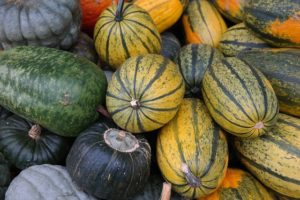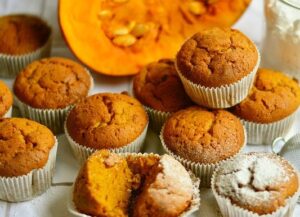 Pumpkins and winter squash are more than just decorations. They are also nutritional superheroes that help keep kids and families healthy. Packed with vitamins A and C, some varieties have as much potassium as a banana and are loaded with fiber, B vitamins and antioxidants. These nutrients support eye health, glowing skin and a strong immune system.
Pumpkins and winter squash are more than just decorations. They are also nutritional superheroes that help keep kids and families healthy. Packed with vitamins A and C, some varieties have as much potassium as a banana and are loaded with fiber, B vitamins and antioxidants. These nutrients support eye health, glowing skin and a strong immune system.
Though called “winter” squash, they grow throughout summer and are picked in the fall before frost. Historically, people stored them in root cellars to last through winter. Depending on the variety, winter squash can last one to six months if harvested, cured, and stored in a cool, dry and well-ventilated space (50-550F).
Versatility of Squash
Winter squash are versatile and easy to incorporate into meals like soups, stews, muffins and smoothies. With so many different types to try, such as pumpkin, acorn, butternut, Hubbard, delicata and spaghetti, you are surely to find one that you enjoy. With all these different shapes, sizes and colors, there are endless ways to make squash exciting and fun for kids.
Tips for Increasing Squash Acceptability:
Help kids see squash as a “superfood” with these fun reminders:
S- Super Strong! Keeps your body strong and healthy!
Q – Quick Energy! It gives energy for playtime!
U – Unbelievably Yummy! It tastes great in many dishes!
A – Awesome for your eyes! Helps your eyes stay healthy!
S – Superfood! Has superpower nutrients!
H – Hooray for Halloween! Pumpkins are fun to decorate and eat!
Easy Ways to Add Squash to Family Meals:
- Start with Familiar Dishes: Add pumpkin or squash to foods your child already likes, such as pancakes, muffins or pasta sauce, to make new foods less intimidating.
- Get Kids Involved: Let kids help scoop out pumpkin seeds and roast them for a healthy snack. It’s a fun way to get them excited about cooking.
- Spice it up: Let your kids be little chefs and create their own seasoning blends for roasted pumpkin and squash seeds using cinnamon, sugar, pumpkin pie spice, garlic powder, salt, pepper, paprika and more.
- Blend it: Cook and blend into smoothies or oatmeal for an easy nutritional boost.
More Ideas to Get Kids Involved
- Turn cooking with pumpkins and winter squash into a fun family adventure! If you don’t have a garden, visit a farmer’s market, pumpkin patch or community garden, letting your kids pick out different squashes and pumpkins.
- In the kitchen, make the process fun and interactive. For Example, encourage kids to explore the different textures, smells, ingredients and tastes as you cook. Keep them curious by asking questions such as, “What do you think will happen when we roast it?” Let them help with safe tasks like washing produce, measuring and mixing.
- Reading recipes aloud makes cooking a learning experience, helping kids learn new words, follow steps and practice math with measurements. Additionally, share fun facts or family stories about squash and pumpkins as you cook. Get creative by using cookie cutters to shape squash or guessing how many seeds are inside.
- Remember, cooking together is about fun and learning. Celebrate their efforts, don’t worry about the mess and enjoy the process. When it’s time to eat, remind them that squash and pumpkins are “superhero fuel” to help them grow strong and healthy!
For a fun recipe for a Pumpkin Pie Oatmeal Smoothie visit the November CSU Family Matters Newsletter

